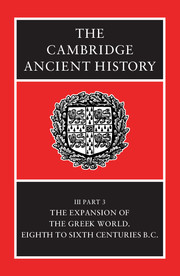Book contents
- Frontmatter
- Contents
- List of maps
- List of text-figures
- Preface
- 36a The Greeks in the Near East
- 36b The Greeks in Egypt
- 36c Cyprus
- 36d The Cypriot syllabary
- 37 The colonial expansion of Greece
- 38 The western Greeks
- 39a The eastern Greeks
- 39b Crete
- 39c Cretan Laws and Society
- 39d Euboea and the Islands
- 40 Illyris, Epirus and Macedonia
- 41 Central Greece and Thessaly
- 42 The Peloponnese
- 43 The growth of the Athenian state
- 44 The Tyranny of Pisistratus
- 45a Economic and social conditions in the Greek world
- 45b The material culture of Archaic Greece
- Chronological Table
- BIBLIOGRAPHY
- Index
- References
36a - The Greeks in the Near East
Published online by Cambridge University Press: 28 March 2008
- Frontmatter
- Contents
- List of maps
- List of text-figures
- Preface
- 36a The Greeks in the Near East
- 36b The Greeks in Egypt
- 36c Cyprus
- 36d The Cypriot syllabary
- 37 The colonial expansion of Greece
- 38 The western Greeks
- 39a The eastern Greeks
- 39b Crete
- 39c Cretan Laws and Society
- 39d Euboea and the Islands
- 40 Illyris, Epirus and Macedonia
- 41 Central Greece and Thessaly
- 42 The Peloponnese
- 43 The growth of the Athenian state
- 44 The Tyranny of Pisistratus
- 45a Economic and social conditions in the Greek world
- 45b The material culture of Archaic Greece
- Chronological Table
- BIBLIOGRAPHY
- Index
- References
Summary
Names and places
The Hellenes, ever since their great movement of renewed expansion that began in the ninth century B.C., have had different names in east and west. Westerners came to know them as Graeci, Greeks. Easterners call them Ionians. Even today, a Greek is an Ionian – a Yūnāni – in Arabic, Turkish and Persian. For the people of the Levant and Mesopotamia to name the Greeks after the Ionians was natural, for it was the Ionians who had come to be the chief inhabitants of the eastern parts of the Greek homeland: the Aegean Islands and the coastline of western Asia Minor. The peculiar form of the name ‘Ionians’ that the ancient Near East adopted is just what we should expect to have resulted from ninth- and eighth-century contacts. From the archaic Greek Iāones < * Iāwones is derived the Yawan of the Bible. The Mesopotamians probably pronounced it the same, though the convention of their syllabary resulted in the spelling Yaman. The name could only have come into use after the Ionians occupied their East Greek territories in the post-Mycenaean period. Homer looked back to an age in which there was as yet no such Ionian settlement. The ‘Iāones with trailing tunics’ only appear once in the Iliad, named together with mainland Greeks in an anachronistic-looking passage (XIII.685). The Iliad here uses the archaic form, as does the Homeric Hymn describing the Ionians' festival on the island of Delos (III. 147, 152), and it was still in use in Solon's time, c. 600 B.C.
- Type
- Chapter
- Information
- The Cambridge Ancient History , pp. 1 - 31Publisher: Cambridge University PressPrint publication year: 1982
References
- 5
- Cited by



